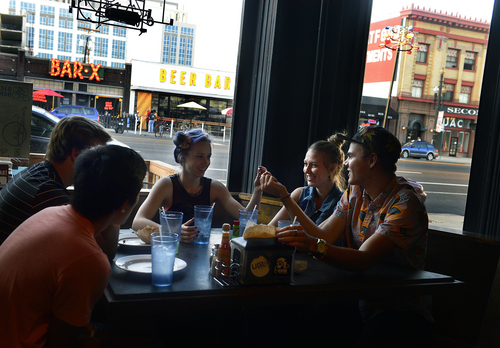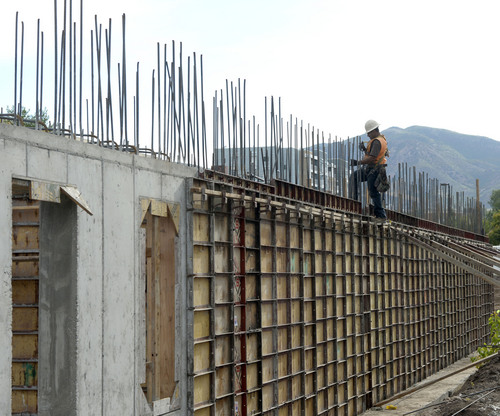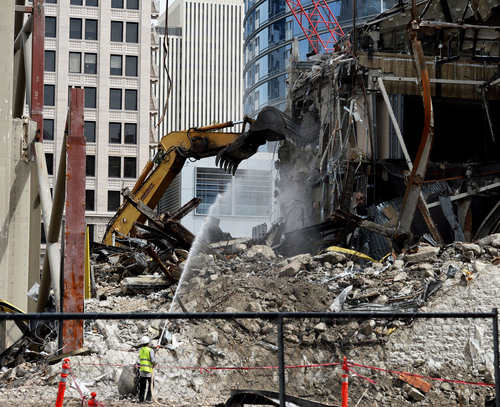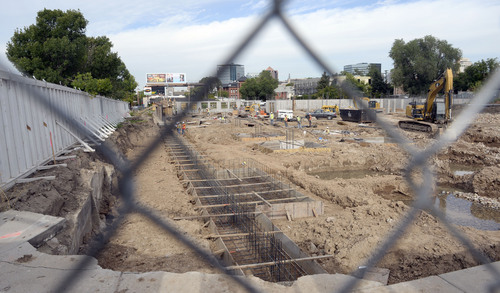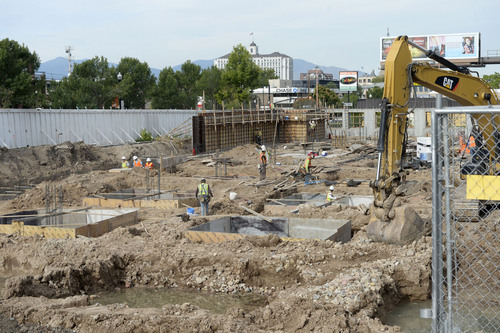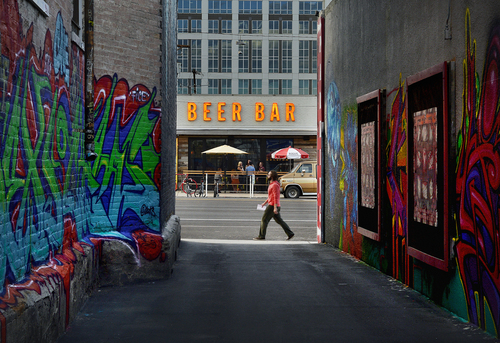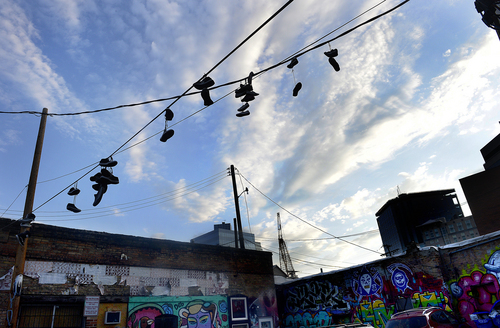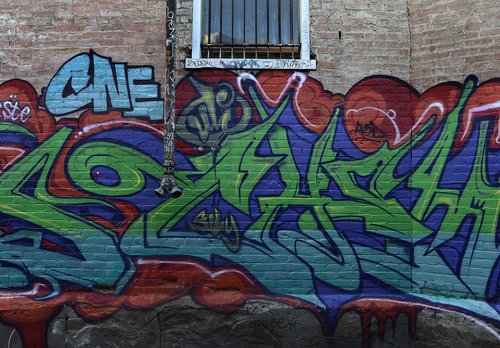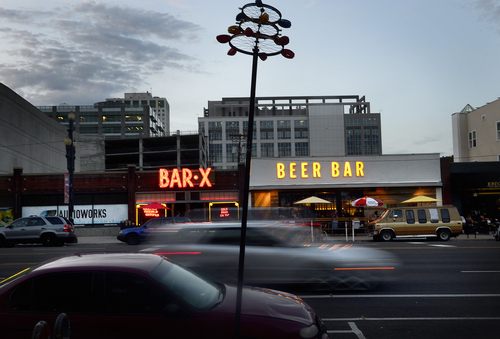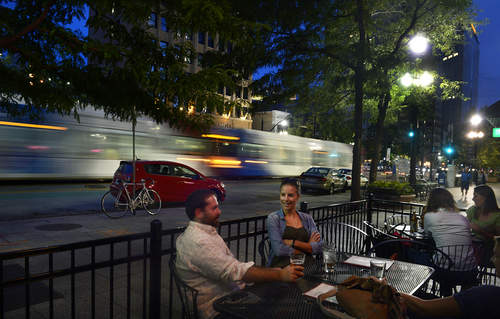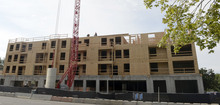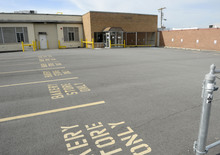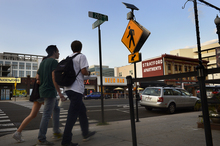This is an archived article that was published on sltrib.com in 2014, and information in the article may be outdated. It is provided only for personal research purposes and may not be reprinted.
They are young, diverse, mobile, socially aware and part of a long-sought transformation in Utah's urban core.
Twenty-somethings are driving a residential boom in the heart of Salt Lake City, with thousands of new apartments, condominiums and town homes being built to cater to the living needs of these so-called millennials.
Utah's younger demographics, its sturdy job market and a blossoming tech sector have combined with a light-rail system and premier outdoor and cultural attractions to lure a large share of this generation to the state's capital.
The rise in city dwellers is helping to revitalize downtown and fulfill a dream of municipal leaders to bolster the metro-residential population base.
"It's pretty exciting to see," said David Everett, chief of staff to Salt Lake City Mayor Ralph Becker. "You can have people visiting and working downtown, but it's not the same."
As downtown millennials go, Guy Warner is not atypical.
The 30-year-old condo resident and his young family take TRAX, ride bikes or walk to traverse the city's long blocks. He frequents the Twilight Concert Series in Pioneer Park and Craft Lake City at the Gallivan Center. A weekend might find the couple at favorite neighborhood bars like Junior's Tavern or Keys on Main.
"We like downtown for the night life," said Warner, a Web developer who grew up in St. George. It's worth commuting to Orem for work each day, he said, to be close to a surging urban vibrancy.
Warner and other millennials say they connect personally with what they see as Salt Lake City's more liberal sensibility, especially when compared with the rest of the Beehive State. Utah's capital hasn't elected a Republican mayor since the mid-1970s, opting instead for left-leaning politicos such as Becker and his predecessor, Rocky Anderson.
"The reason why I'm so attracted to Salt Lake is the progressive ideas," explained Isabel Mejia, a 29-year-old nutritionist and Los Angeles transplant who runs her own consulting company and lives downtown. "Even on things as simple as recycling or farmers markets and caring about being green, I definitely think Salt Lake is leading the way."
—
The young and the zestless • Downtown is also drawing middle-age families and older couples whose children have left home, known as empty nesters, but millennials are considered the shape of things to come if only for their sheer numbers.
Born between 1980 and 2000, they make up the largest U.S. generation at 80 million strong, narrowly bypassing baby boomers reared between World War II and the early 1960s. The latest U.S. census puts the 20- to 30-year-old set at about a quarter of all Americans.
Unlike members of prior population bulges, this group is more cohesive in its views, a reflection of growing up with near-instant access to a body of world knowledge via the Internet, according to a leading national expert on the subject.
Millennials tend to be well-educated, idealistic and globally minded, believing in inclusion, tolerance, social responsibility and the value of meaningful personal experiences over consumption, said David Burstein, author of "Fast Future: How the Millennial Generation Is Shaping Our World."
The author recently delivered a pep talk to Salt Lake City business owners eager to court this incoming population cluster, both as customers and talented, tech-savvy employees.
"Combined with the size of the generation, that common sense of values is pretty powerful," Burstein, 25, said in an interview. "Entire industries are dealing with how to cater to this generation."
—
There's no place like ... renting • Key to downtown Salt Lake City's housing picture, millennials seem to prefer renting as opposed buying a home.
They want mobility and are delaying marriage and having kids. They are more likely to carry student debt and face tighter lending conditions than their parents or grandparents did. More basically, they've had their faith in an ever-rising housing market shaken by the Great Recession.
For some, it comes down to basic lifestyle choices.
"I miss having a yard," Warner said, "but I don't miss yardwork."
In past decades, Utah has ranked as one of the highest U.S. states for homeownership, a metric closely tied to The Church of Jesus Christ of Latter-day Saints and its family emphasis. But federal housing numbers reveal that ratio has slipped from 76.2 percent in 2008 to 70.9 last year. The shift is even more pronounced for 25- to 34-year-olds, statistics show.
Mirroring that decline, vacancy rates on apartments is now at 3 percent in Salt Lake County, the lowest rate in 13 years and down nearly an entire percentage point from a year ago. Rents continue to inch upward, particularly for newly built and more-upscale dwellings.
Those numbers have Utah's housing developers and investors paddling hard to catch the wave of what are referred to as "lifestyle renters." Land in downtown's core is selling at a premium and dozens of the state's biggest builders are diving in — even companies traditionally known for erecting single-family homes in the suburbs.
Ivory Homes, for one, recently announced a mixed-use project that will include apartments, near 200 East and 300 South. "Being close to TRAX is helpful," said Chris Gamvroulas, president of Ivory's development arm, "but it's everything else that goes along with being in a downtown area."
—
People power • Salt Lake City saw around 725 market-rate apartments built from 2001 to 2010. In the past four years alone, that number jumped to 2,112, according to a new study. And the trend keeps climbing. More than 6,000 units are planned countywide during the next two years, it says.
Already, scores of projects — each with between a dozen and hundreds of one- to four-bedroom units — are popping up across the city's skyline, with such names at Seasons at Liberty Square, Bridges at Citifront, Broadway Park Lofts and 644 City Station.
The appetite for rentals shows few signs of easing during the next year, said Jim Wood, the study's author and director of the University of Utah's Bureau of Economic and Business Research.
"Market conditions for apartment owners will continue to be favorable," he wrote.
All of this is happening as the city reaches the final stages of a once-per-generation rewriting of its planning blueprint for downtown. The draft master plan envisions a quadrupling of the downtown resident population by 2040 — from about 5,000 people as measured in 2010 to 20,000 three decades from now.
If those projections bear out, the effect could bring critical mass to the city's decades-old goal of creating a 24/7 downtown, akin to major metro areas such as Portland or Seattle. The new residents, the plan says, may well "activate downtown by patronizing downtown businesses, enlivening the public realm and visiting its parks and public spaces" around the clock.
People, says one advocate, are the dynamic ingredient that makes everything else in a downtown work.
"Downtown residents increase safety and security, economic activity, cultural activities and street-level vibrancy,'' said Jason Mathis, director of the business- and city-backed Downtown Alliance. "This is especially true with younger people who tend to stay out later and walk more."
—
The City Creek boost • Other factors are accelerating the pace of higher-density, multifamily-housing construction in the central business district, a 700-acre footprint bounded by Interstate 15, North Temple, 200 East and 900 South.
The city has steadily added urban attractions in the past 25 years. These range from the Utah Jazz's 19,911-seat arena in 1991 to an array of arts and cultural fairs, music venues, galleries, restaurants, taverns, hotels and hundreds of boutique stores and businesses. And a Broadway-caliber theater is on its way.
Though downtown is still car-centric in many ways, with vast swaths of surface parking, elected leaders have widened walkability and pushed for bike lanes, particularly under Becker's tenure. Both have major millennial appeal.
Utah's ski and winter sports industry provides an undeniable draw more than a decade after the 2002 Winter Olympics raised its profile worldwide. The region's colleges and universities — including added campuses downtown — bring in thousands of students, and many stay once they graduate.
A healthy share of credit goes to the LDS Church for building its $1.5 billion City Creek Center shopping complex, according to downtown boosters and commercial real-estate insiders. Spanning two blocks and fronting Main Street, the luxurious and grand-scale mall opened in 2011 and is now hitting its intended stride, helping the city's core amass a record $800 million in retail sales for 2013.
According to Kip Paul, executive director of investment sales for Cushman & Wakefield | Commerce Real Estate Solutions: "To say they primed the pump is an understatement."
Some worried that City Creek — with its 536 apartments and condos — and the presence of LDS Business College and a Brigham Young University campus at the Triad Center would spur a Mormonization of downtown, leaving those outside the state's predominant religion feeling uneasy if not unwelcome. But those fears have largely evaporated
The LDS Church remains a vast and expanding presence — with the faith's headquarters and signature temple as city centerpieces — and more Latter-day Saints are moving downtown. But so, too, are varied blends of other believers and nonbelievers.
Millennials, author Burstein notes, tend to be spiritual but less religious as a group, while lacking trust in institutions in general.
—
Zoning for dollars • Part of the boom is a rebound effect from the 2007 housing crash as builders catch up to pent-up demand. At the same time, city leaders have laid foundations for the population spurt in less-obvious ways.
During the past several years, planners at City Hall have quietly rezoned lots along North Temple, 400 South and 900 South to better tap the potential of light-rail lines. They also created a point system that expedites projects considered beneficial to urban vitality, deploying what's known as form-based zoning to regulate new construction according to its look, shape and size instead of its intended use.
"I hesitate to say the big boom is all due to those changes," City Planning Director Wilf Sommerkorn said, "but it certainly played a big part."
The influx of Generation Y poses major challenges as well.
The city's core is low on residential amenities such as grocery stores — a new Harmons across from City Creek Center fills with shoppers — and green spaces for those who want a verdant place to walk the dog or let the kids play.
"There's Pioneer Park, Liberty Park, maybe a couple of things sprinkled in between — and that's it,'' groused 26-year-old Eric Biggart, who walks to work downtown from his newly purchased home near East High.
The city raised its impact fees on new apartments two years ago to help pay for new parks, then lowered them a year later amid claims they made projects too expensive and rents less affordable. Planners also note a difficult balance between giving development room and retaining historic and funky older buildings that give the city charm.
What's more, the new stock of apartments is notably heavy on one- and two-bedroom units, potentially squeezing out larger families and making downtown too millennial-centered over time.
"We need to continue to build for families of various types," said City Councilman Luke Garrott, whose district covers downtown. "You have to have diversity of incomes, races, ages, religions and lifestyles to have the vital energy of a great city."
So, millennials are welcome but it takes all kinds to make a downtown.
Twitter: @Tony_Semerad



